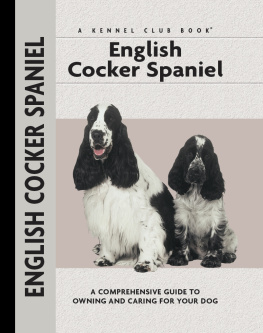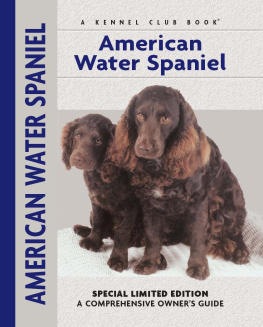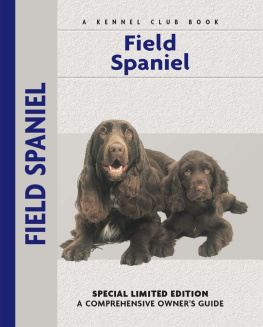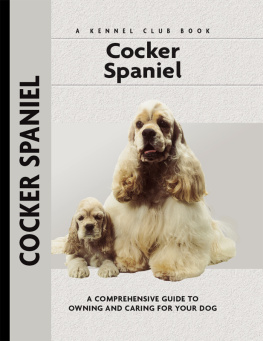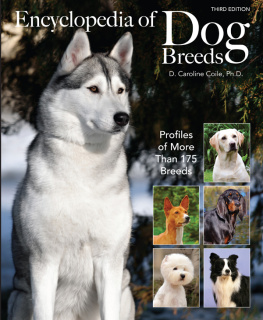Physical Characteristics of the Sussex Spaniel
(from the American Kennel Club breed standard)
Eyes: Hazel in color, fairly large, soft and languishing.
Nostrils: Well-developed and liver colored.
Lips: Somewhat pendulous.

Bite: A scissors bite is preferred.
Ears: Thick, fairly large and lobe-shaped and are set moderately low.
Forequarters: The shoulders are well laid back and muscular. The forelegs should be very short, strong and heavily boned. Both straight and slightly bowed constructions are proper and correct. The pasterns are very short and heavily boned.
Proportion: Longer in body than it is tall.
Substance: Muscular and rather massive.
Coat: The body coat is abundant, flat or slightly waved, with no tendency to curl.
Skull: Moderately long and also wide with an indentation in the middle and with a full stop.
Neck: Rather short, strong and slightly arched.
Body: Low and long with a level topline.
Height: Measured at the withers ranges from 13 to 15 inches.
Weight: Ranges between 35 and 45 pounds.
Tail: Docked from 5 to 7 inches and set low.
Hindquarters: Full and well-rounded, strong and heavily boned. They should be parallel with each other and also set wide apart. The hind legs are short from the hock to the ground, heavily boned. The hindquarters must correspond in angulation to the forequarters.
Color: Rich golden liver is the only
Feet: Large and round with short hair between the toes.
Contents

Make the acquaintance of the distinctive Sussex Spaniel , one of the rarest of the sporting spaniels, and trace the breeds origins from Sussex County in England. Learn about the early dogs and founding breeders, and meet those responsible for promoting the breed around the world today.

Despite his somewhat somber expression, here is a cheerful yet calm companion dog, seeking a home with sensible, good-humored owners. Find out if you are a Sussex person, ready to deal with all of the breeds delightful antics and amusing character traits. The chapter also discusses physical characteristics and breed-specific health concerns.

Learn the requirements of a well-bred Sussex Spaniel by studying the description of the breed set forth in the American Kennel Club standard. Both show dogs and pets must possess key characteristics as outlined in the breed standard.
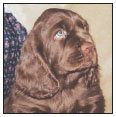
Find out about how to locate a well-bred Sussex Spaniel puppy. Discover which questions to ask the breeder and what to expect when visiting the litter. Prepare for your puppy-accessory shopping spree. Also discussed are home safety, the first trip to the vet, socialization and solving basic puppy problems.
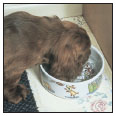
Cover the specifics of taking care of your Sussex Spaniel every day: feeding for all life stages; grooming, including coat care, ears, eyes, nails and more; and exercise for your dog. Also discuss the essentials of dog ID, safe travel and boarding.
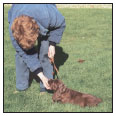
Begin with the basics of training the puppy and adult dog. Learn the principles of house-training the Sussex Spaniel , including the use of crates and basic scent instincts. Get started by introducing the pup to his collar and leash and progress to the basic commands. Find out about obedience classes and other activities.

By Lowell Ackerman DVM, DACVD
Become your dogs healthcare advocate and a well-educated canine keeper. Select a skilled and able veterinarian. Discuss pet insurance, vaccinations and infectious diseases, the neuter/spay decision and a sensible, effective plan for parasite control, including fleas, ticks and worms.

Know when to consider your Sussex Spaniel a senior and what special needs he will have. Learn to recognize the signs of aging in terms of physical and behavioral traits and what your vet can do to optimize your dogs golden years.

Step into the center ring and find out about the world of showing pure-bred dogs. Heres how to get started in AKC conformation shows, how they are organized and whats required for your dog to become a champion. Explore other areas of the dog sport, including obedience, agility, rally and hunting events.
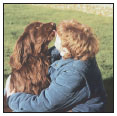
Analyze the canine mind to understand what makes your Sussex Spaniel tick. Potential problems addressed include different types of aggression, separation anxiety, sexual behavior, chewing, digging, barking and food-related problems.
K ENNEL C LUB B OOKS S USSEX S PANIEL
ISBN 13: 978-1-59378-359-4
eISBN 13: 978-1-62187-050-0
Copyright 2007 Kennel Club Books A Division of I-5 Publishing, LLC
3 Burroughs, Irvine, CA 92618 USA
Cover Design Patented: US 6,435,559 B2 Printed in South Korea
All rights reserved. No part of this book may be reproduced in any form, by photostat, scanner, microfilm, xerography or any other means, or incorporated into any information retrieval system, electronic or mechanical, without the written permission of the copyright owner.
Library of Congress Cataloging-in-Publication Data
Hirschy, Becki Jo.
Sussex spaniel / by Becki Jo Hirschy.
p. cm.
ISBN 1-59378-359-0
1. Sussex spaniel. I. Title.
SF429.S88H57 2006
636.7524dc22
2006012320
10 9 8 7 6 5 4 3 2 1
Photography by Carol Ann Johnson
with additional photographs by:
Ashbey Photography, Norvia Behling, Booth Photography by Monica, Paulette Braun, Isabelle Franais, Bill Jonas, Don and Becky Krueger, Chuck Tatham, Alice van Kempen and Otto Wahl.
Illustrations by Patricia Peters.
The publisher wishes to thank all of the owners whose dogs are featured in this book, including Jean Burnett, Beth Dowd, Jeane Haverick, Jan Hepper, Don and Becky Krueger, Helen Marshall, Erin Miller, Lindsey Miller, Dr. Marlin and Sheila Reaknow, Cecelia Ruggles, Linda Shannon and Liz Shewell.

Next page




